So, my dear, we have collected our schematics and it's time to check it, to experience and rejoice in this happiness. Next to us is the connection of the circuit to the power source. Let's get started. On batteries, batteries and other bells and whistles of power we will not stop, we will pass immediately to the network power sources. Here we consider the existing rectification schemes, how they work and what they can. For experiments, we need a single-phase (at home from the outlet) voltage and the corresponding parts. Three-phase rectifiers are used in industry, we will not consider them either. Then you will grow electricians - then, please.
The power supply consists of a few of the most important details: A mains transformer is indicated in the diagram similar to the figure,
Rectifier - its designation can be different. The rectifier consists of one, two or four diodes, depending on which rectifier. Now we will understand.
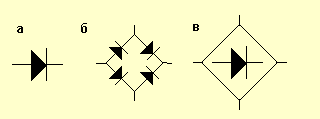
a) is a simple diode.
b) a diode bridge. It consists of four diodes, included as in the figure.
c) - the same diode bridge, only for simplicity is drawn simpler. The assignments of contacts are the same as for a bridge under the letter b).
Filter capacitor. This thing is invariable both in time and in space, is denoted as follows:
The capacitor has many notations, as many as in the world of notation systems. But in general they are all alike. Do not get confused. And for clarity we will draw a load, we will designate it as Rl - load resistance. This is our scheme. We will also outline the power supply contacts to which we will connect this load.
Next - a couple of postulates.
- The output voltage is defined as Uost = U * 1.41. That is, if on the winding we have 10 volts of alternating voltage, then on the capacitor and on the load we get 14.1V. Like that.
- Under load, the voltage sags a little, and how much depends on the design of the transformer, its power and capacitor capacitance.
- Rectifier diodes should be 1.5-2 times more current than required. For stock. If the diode is intended for installation on a radiator (with a nut or a bolt hole), then at a current of more than 2-3A it should be placed on the radiator.
Just remind you what a bipolar voltage is. If someone has forgotten. We take two batteries and connect them in series. The midpoint, that is, the point of connection of the batteries, will be called a common point. In the people it is known as well as mass, earth, body, common wire. Bourgois call it GND (ground), often referred to as 0V (zero volts). Voltmeters and oscilloscopes are connected to this wire, relative to it, input signals are sent to the circuits and the output is taken. Therefore, its name is a common wire. So, if we connect the tester with a black wire to this point and measure the voltage on the batteries, then on one battery the tester will show plus1.5 volts, and on the other - minus 1.5 volts. This voltage is +/- 1,5V and is called bipolar. Both polarities, that is, plus and minus, must necessarily be equal. That is +/- 12, +/- 36V, +/- 50, etc. A sign of bipolar voltage - if three wires (plus, common, minus) go from the circuit to the power unit. But not always so - if we see that the circuit is powered by +12 and -5, then this power supply is called two-level, but there will still be three wires to the power supply. Well, if there are four voltages on the circuit, for example +/- 15 and +/- 36, then this power is simply called a bipolar two-level voltage.
Well, now to the point.

1. Bridge rectification scheme.
The most common scheme. It allows to receive unipolar voltage from one winding of the transformer. The circuit has minimal voltage pulsations and is simple in design.
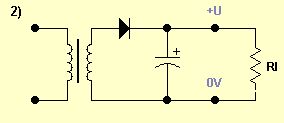
2. A half-wave circuit.
Just like the roadway, we are preparing a unipolar voltage from one winding of the transformer. The only difference is that this circuit has twice the ripple compared to the bridge, but one diode instead of four greatly simplifies the circuit. Used for small load currents, and only with a transformer, much higher load power, because such a rectifier causes a one-way reversal of the transformer.
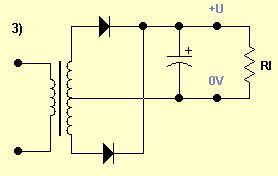
3. Full-wave with mid-point.
Two diodes and two windings (or one winding with an average point) will feed us with a low-pulsating voltage, plus we will get less losses in comparison with the bridge circuit, because we have 2 diodes instead of four.
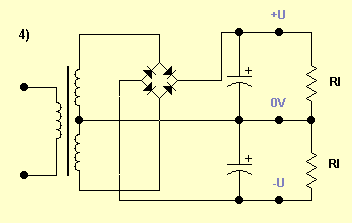
4. Bridge circuit of a bipolar rectifier.
For many - a painful topic. We have two windings (or one with an average point), we remove two identical voltages from them. They will be equal, the pulsations will be small, since the bridge circuit, the voltage on each capacitor is considered as the voltage on each winding multiplied by the root of the two - everything, as usual. The wire from the midpoint of the windings equalizes the voltage across the capacitors if the loads in plus and minus are different.
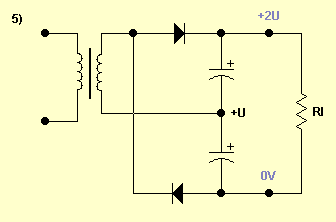
5. A circuit with a voltage doubling.
These are two half-wave circuits, but with diodes included in different ways. Applicable if we need to get doubled voltage. The voltage at each capacitor will be determined by our formula, and the total voltage on them will be doubled. Like the half-wave circuit, this one also has large pulsations. In it you can see a bipolar output - if the middle point of the capacitors is called the earth, then it turns out as in the case of batteries, take a closer look. But much power with such a scheme can not be removed.
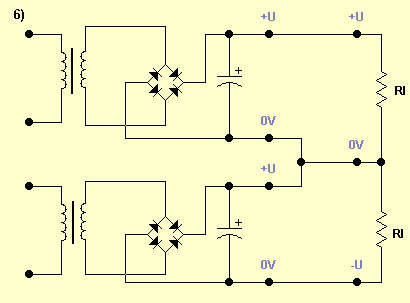
6. Reception of a non-polar voltage from two rectifiers.
It is not necessary that these are the same power supplies - they can be either different in voltage or different in power. For example, if our scheme consumes 1A for +12 volts, and for -5 volts - 0.5A, then we need two power supplies - + 12V 1A and -5V 0.5A. It is also possible to connect two identical rectifiers to obtain a bipolar voltage, for example, to power the amplifier.

7. Parallel connection of identical rectifiers.
It gives us the same voltage, only with a doubled current. If we connect two rectifiers, then we will have a double current increase, three - triple, etc.
Well, if you, dear ones, understand everything, then let's ask, perhaps, the homework. Formula for calculating the capacitance of a filter capacitor for a full-wave rectifier: 
For a half-wave rectifier, the formula is somewhat different: 
Two in the denominator is the number of "bars" of straightening. For a three-phase rectifier, there will be a triple in the denominator.
In all formulas, the variables are called:
Cf is the capacitance of the filter capacitor, uF
Po - output power, W
U - output rectified voltage, V
f - frequency of alternating voltage, Hz
dU - the range of pulsations, V
For reference - permissible pulsations:
Microphone amplifiers - 0.001 ... 0.01%
Digital technology - pulsations 0.1 ... 1%
Power amplifiers - pulsations of a loaded power supply 1 ... 10%, depending on the quality of the amplifier.
These two formulas are valid for voltage rectifiers with frequencies up to 30kHz. At higher frequencies, electrolytic capacitors lose their efficiency, and the rectifier is calculated a little differently. But that is another topic.
The bridge is across the river, across the ravine, and across the road. But did you ever hear the phrase "diode bridge"? What kind of bridge? But we will try to find an answer to this question.
The phrase "diode bridge" is formed from the word "diode". So, the diode bridge should consist of diodes. But if there are diodes in the diode bridge, then in one direction the diode will transmit an electric current, but in the other there is not. This property of the diodes we used to determine their performance. Who does not remember how we did it, then you here. Therefore, a bridge of diodes is used to obtain a constant voltage from an alternating voltage.
And here is the diagram of the diode bridge:
Sometimes in schemes it is also denoted:
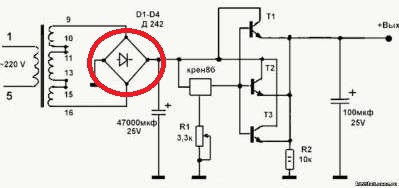
As you and I see, the circuit consists of four diodes. But in order for the diode bridge to work, we must correctly connect the diodes, and correctly apply an alternating voltage to them. On the left we see two "~" icons. On these two outputs, we apply an alternating voltage, and remove the DC voltage from the other two conclusions: with the plus and minus.
In order to convert an alternating voltage into a constant one, one diode can be used for rectification, but it is not desirable. Let's look at the picture:
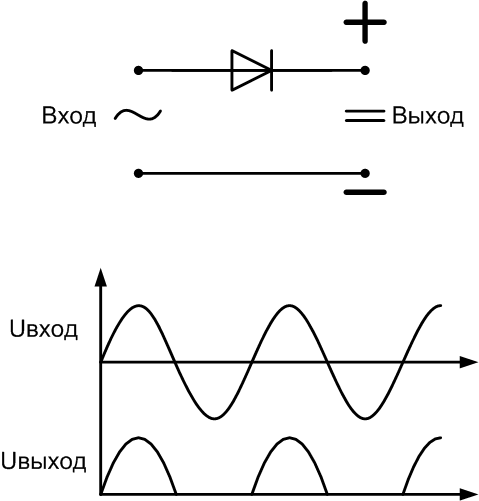
The alternating voltage varies with time. The diode passes through itself the voltage only when the voltage is above zero, when it becomes below zero, the diode is locked. I think everything is elementary and simple. The diode cuts the negative half-wave, leaving only a positive half-wave, which we see in the picture above. And all the charm of this simple circuitry is that we get a constant voltage from the variable.The whole problem is that we lose half the AC power. Her bluntly cuts the diode.
To remedy this situation, a diode bridge was designed. The diode bridge "turns" the negative half-wave, turning it into a positive half-wave. Thus, the power is preserved. Is not it wonderful?
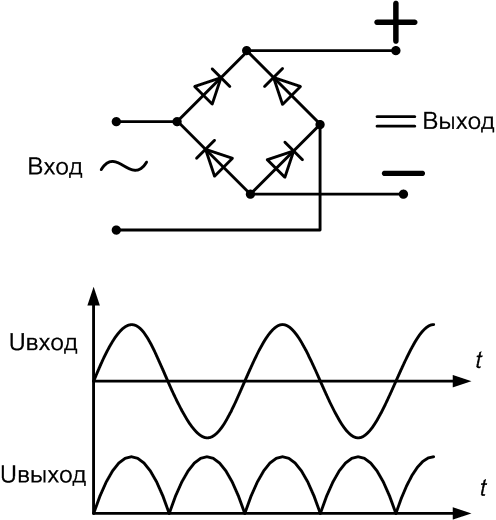
At the output of the diode bridge, we have a constant pulsating voltage with a frequency of twice as much as the network frequency: 100 Hz.
I think you do not need to write how the circuit works, you still do not need it, the main thing is to remember where the alternating voltage clings to, and where the constant pulsating voltage comes from.
Let's see in practice how the diode and the diode bridge work.
First we take a diode.

I blew it out of the computer power supply. The cathode can be easily recognized by a strip. Almost all manufacturers show a cathode strip or dot.
In order for our experiments to be safe, I took a step-down transformer, which of the 220 volts transforms 12 volts. Who does not know how he does it, you can read the article transformer arrangement.

On the primary winding hooked 220 volts, with the secondary take off 12 volts. The cartoon shows a little more, since no load is attached to the secondary winding. The transformer operates on a so-called "idle".
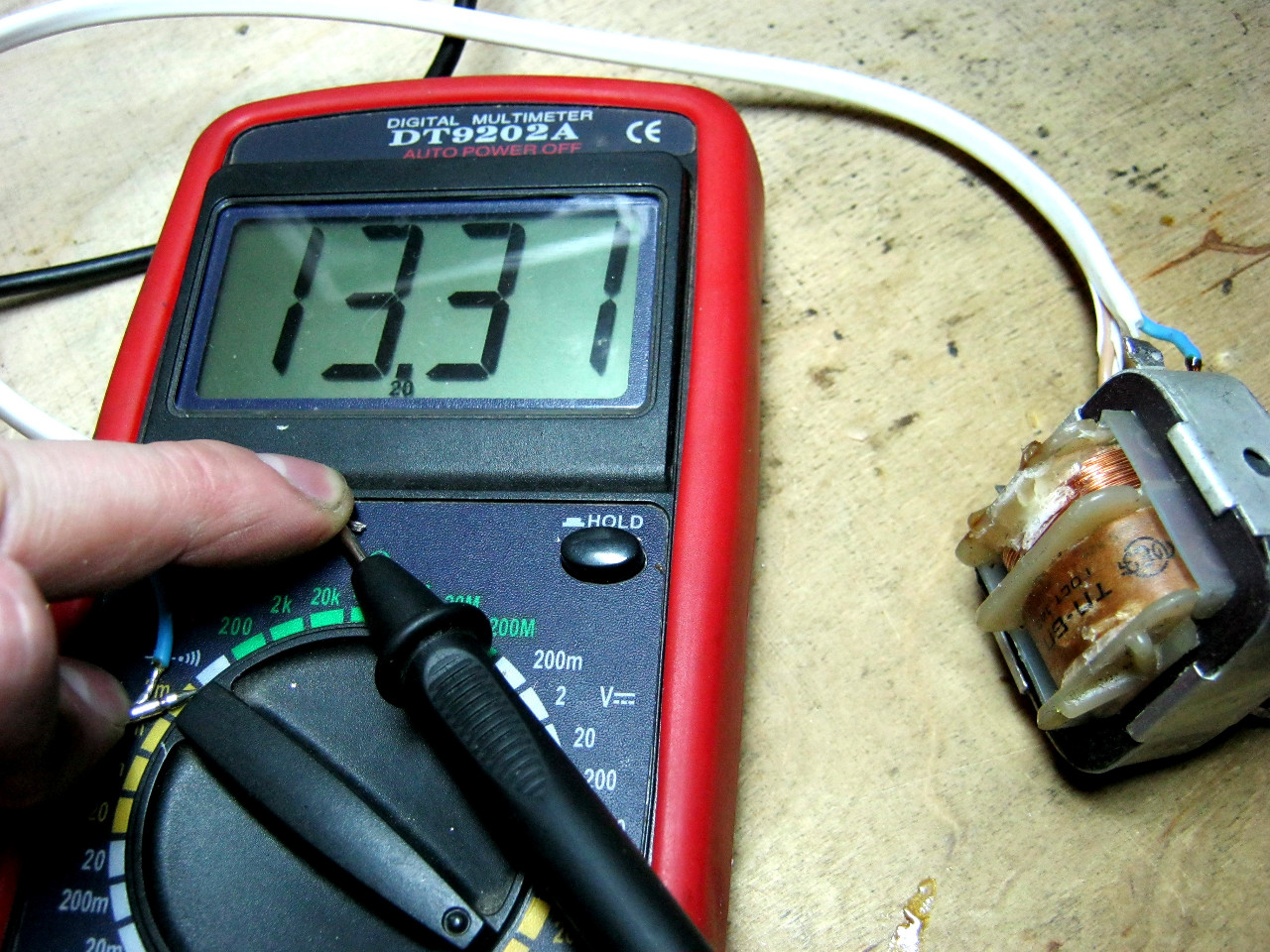
Let's examine the oscillogram that comes with the secondary winding trance. It is not difficult to calculate the maximum amplitude. If you do not remember how to calculate, you can look at the article Oscilloscope. Basics of operation . 3,3х5 = 16.5В is the maximum value of voltage. And if you divide the maximum value of the amplitude by the root of two, then we get 11.8 volts. That's what it is effective value of voltage . Oscilla is not lying, everything is OK.
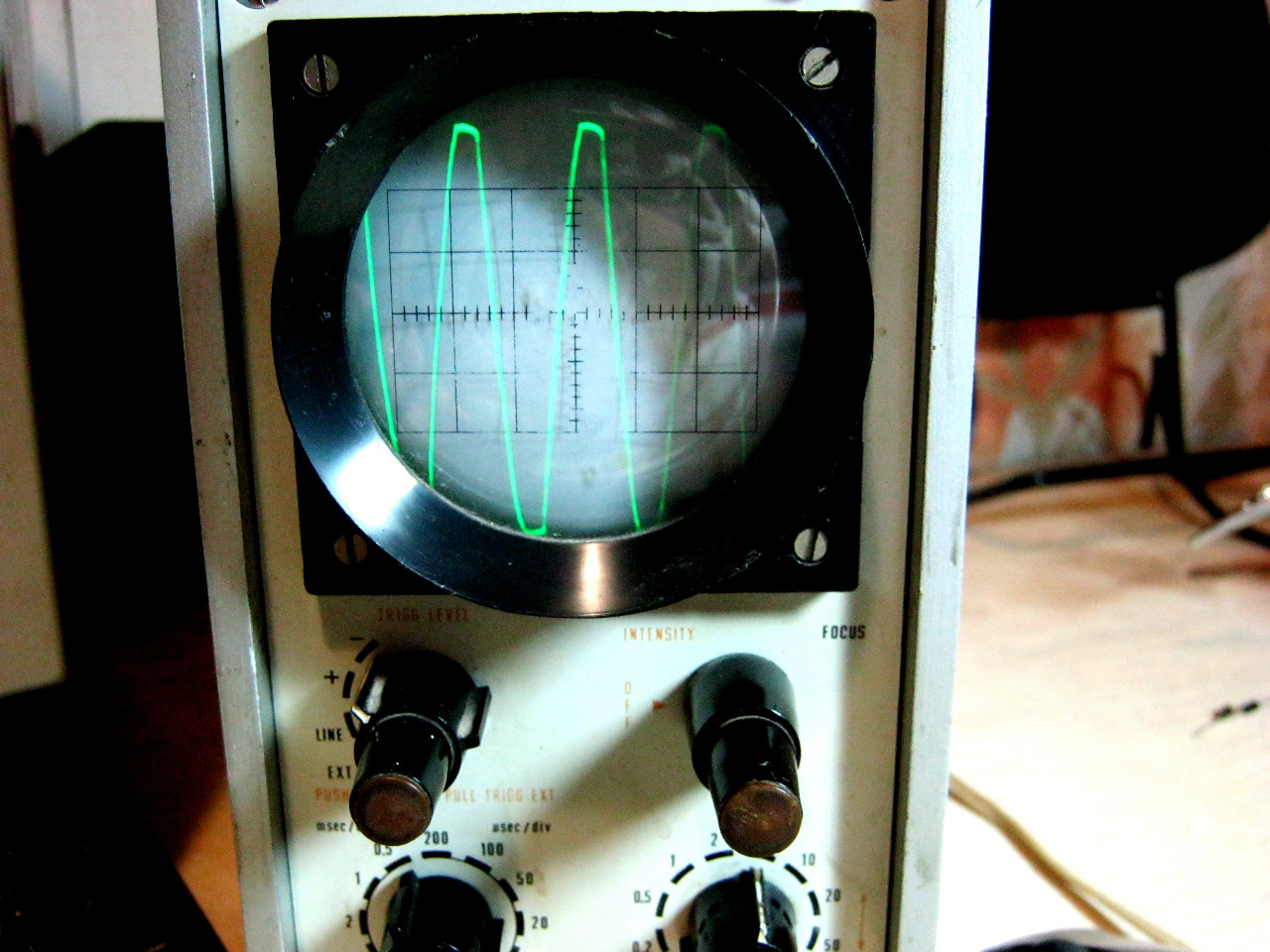
Once again, I could use 220 volts, but 220 volts is not a joke, so I lowered the AC voltage.
We solder our diode to one end of the secondary winding of the trance.

Cling again with dipstick probes

We look at the oscilla
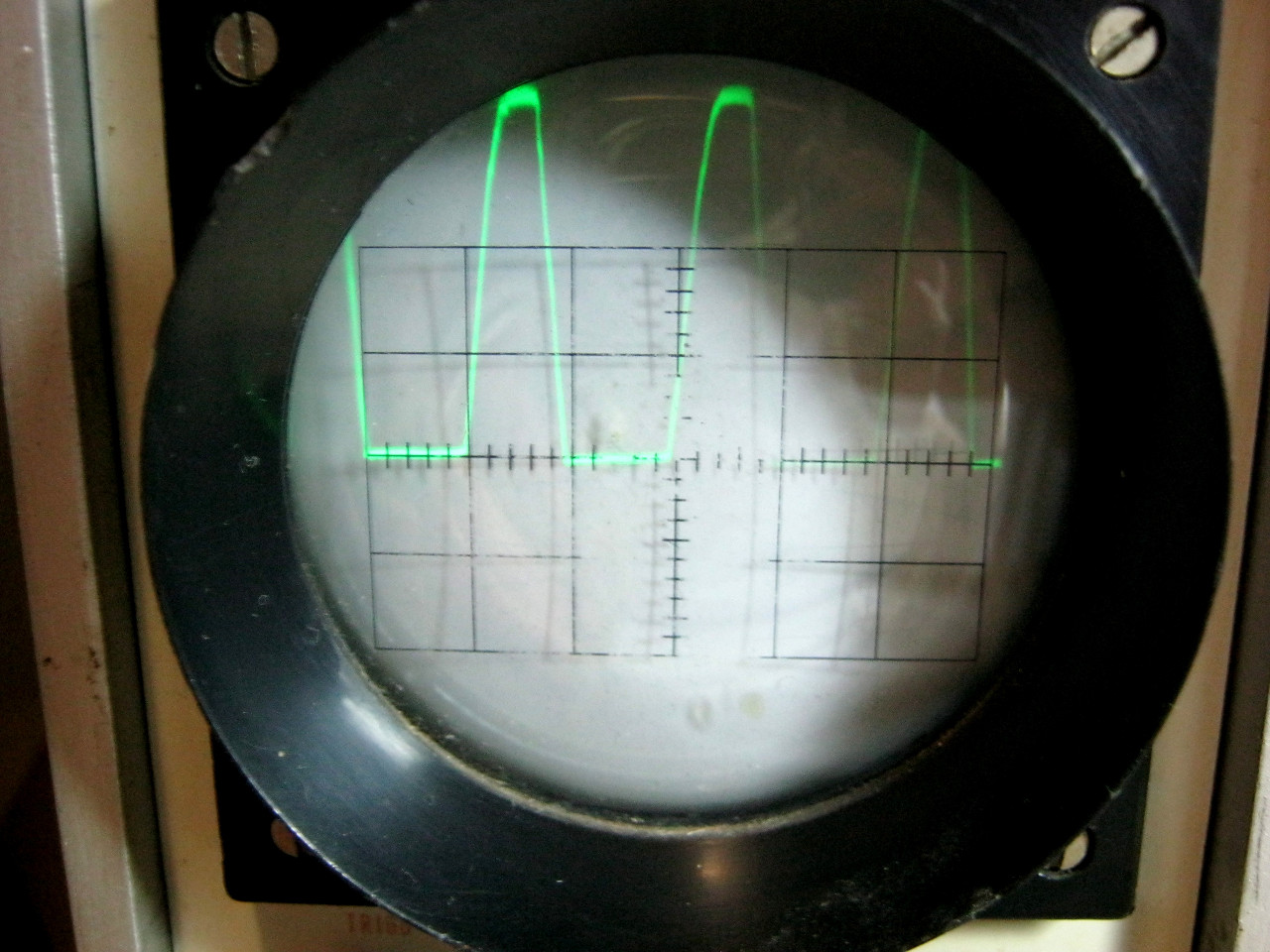
And where is the bottom part of the image? She cut off the diode. The diode left only the upper part, that is, the one that is positive. And since he cut the bottom part, he consequently cut off the power.
We find three more such a diode and solder the diode bridge.

We cling to the secondary winding of trance according to the diode bridge scheme.

From the other two ends, we remove the constant pulsating voltage with the probes of the oscillator and look at the oscillator.
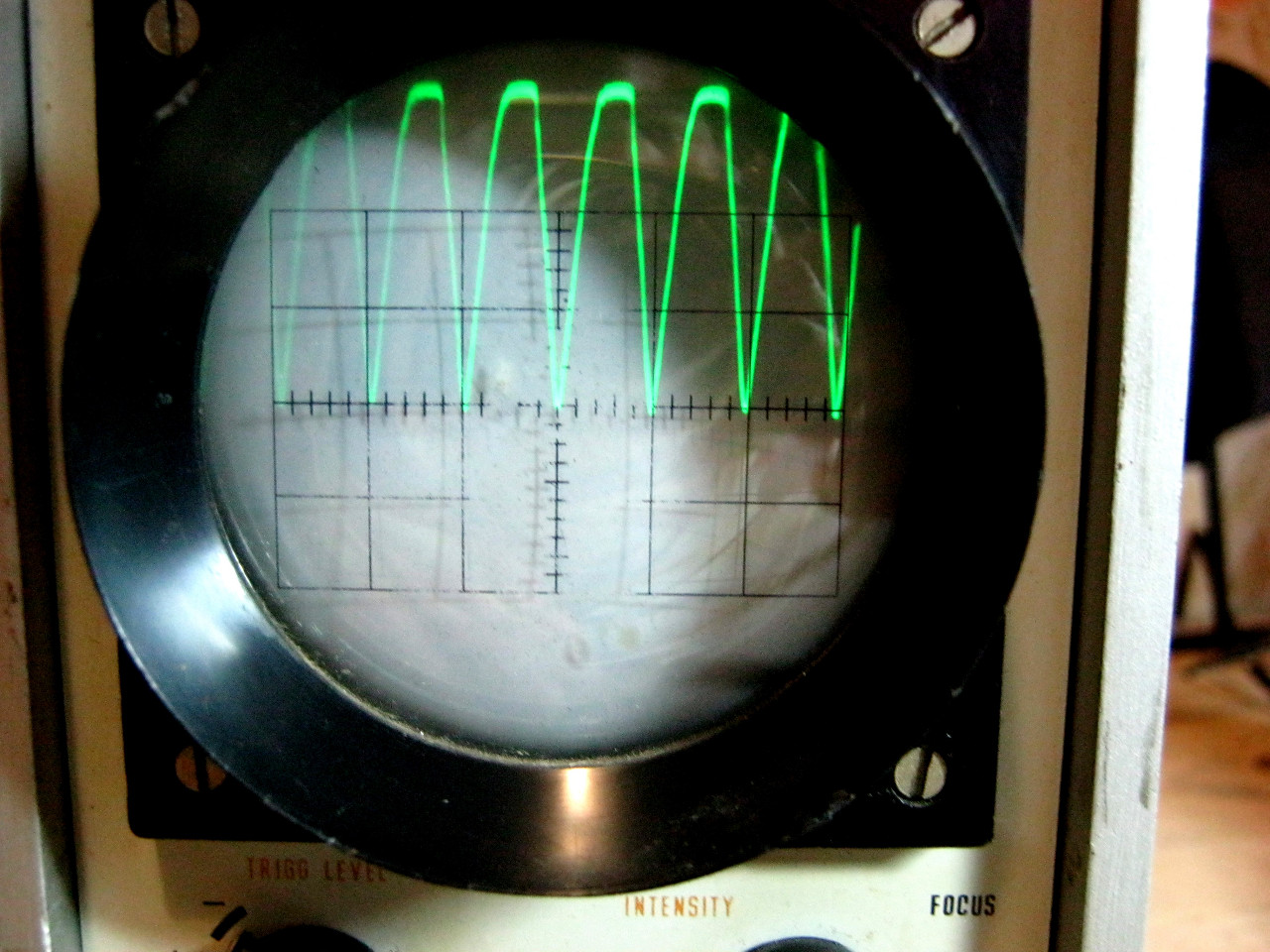
Now, now the order, and the power we have not lost anywhere :-).
In order not to mess with the diodes, the developers put all four diodes in one case. The result is a very compact and convenient diode bridge. I think you'll guess where the imported, and where the Soviet))).

And here is the Soviet one:

And how did you guess? :-) For example, on the Soviet diode bridge, contacts are shown for which an alternating voltage ("~") is to be indicated, and the contacts from which a constant pulsating voltage ("+" and "-") are to be displayed.
Let's check the imported diode bridge. To do this, we catch two of its contacts to the change, and from two other contacts we take the readings to the oscilloscope.

And here is the oscillogram:

So the imported diode bridge works chiki-puki.
In conclusion, I would like to add that the diode bridge is used almost in all radio equipment, which eats the voltage from the network, whether it's a simple TV or even charging for a cell phone. The diode bridge is checked by serviceability of all its diodes.
In many electronic devices operating at alternating current of 220 volts, diode bridges are installed. Diode bridge circuit for 12 volts allows you to effectively perform the function of rectifying an alternating current. This is due to the fact that most devices use direct current.
How the diode bridge works
An alternating current having a certain varying frequency is applied to the input contacts of the bridge. On outputs with a positive and negative value, a unipolar current is formed, which has an increased pulsation, much higher than the frequency of the current applied to the input.
The appearing pulsations must necessarily be removed, otherwise the electronic circuit will not be able to work normally. Therefore, in the scheme there are special filters, which are electrolytic with a large capacity.
The assembly of the bridge itself consists of four diodes with the same parameters. They are connected in a common circuit and placed in a common housing.
The diode bridge has four outputs. Two of them are connected to an alternating voltage, and the other two are a positive and negative terminal of the pulsating rectified voltage.
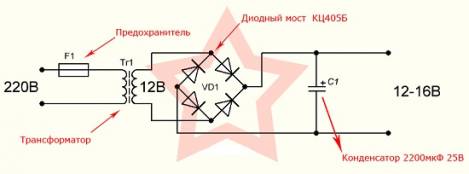
The rectifier bridge in the form of a diode assembly has significant technological advantages. Thus, one monolithic piece is installed on the printed circuit board. During operation, the same thermal conditions are provided for all diodes. The cost of the general assembly is lower than four diodes separately. However, this part has a serious drawback. If one diode is damaged, the entire assembly must be replaced. If desired, any general scheme can be replaced by four separate parts.
Application of diode bridges
In any instrument and electronics, for which a variable electrical current is used, there is a diode bridge circuit for 12 volts. It is used not only in transformer, but also in impulse rectifiers. The most characteristic impulse block is a computer power supply.
In addition, diode bridges are used in fluorescent compact lamps or in energy-saving lamps. They give a very good effect when used in electronic control gears. Widely used in all models of modern devices.
How to make a diode bridge
The diode bridge will help you to convert an alternating current into a constant one - the circuit and the principle of operation of this device are given below. In an ordinary lighting circuit, an alternating current flows, which changes its magnitude and direction 50 times within one second. Its transformation into a constant is a rather frequent necessity.
The operating principle of a semiconductor diode
Fig. 1The name of the described device clearly indicates that this design consists of diodes - semiconductor devices that conduct electricity well in one direction and practically do not conduct it in the opposite direction. The image of this device (VD1) in the circuit diagrams is shown in Fig. 2c. When the current flows through it in the forward direction - from the anode (left) to the cathode (right), its resistance is small. When the direction of the current is changed to the opposite resistance of the diode, it increases manifold. In this case, a slightly different reverse current flows through it.
Therefore, when a variable voltage U in (left-hand graph) is applied to a chain containing a diode, electricity flows through the load only during positive half-periods when a positive voltage is applied to the anode. The negative half-cycles are "cut off", and there is practically no current in the load resistance at this time.
Strictly speaking, the output voltage U out (right graph) is not constant, although it flows in one direction, but pulsating. It is easy to understand that the number of pulses (pulsations) in one second is 50. This is not always permissible, but pulsations can be smoothed by connecting a capacitor having a sufficiently large capacitance parallel to the load. Charging during voltage pulses, in the intervals between them, the capacitor discharges to load resistance. Pulsations are smoothed out, and the voltage becomes close to constant.
The rectifier made in accordance with this scheme is called a half-wave rectifier, since only one half-period of the rectified voltage is used in it. The most significant disadvantages of such a rectifier are as follows:
- increased ripple of rectified voltage;
- low efficiency;
- the large weight of the transformer and its inefficient use.
Therefore, such circuits are used only for powering low-power devices. To rectify this undesirable situation, full-wave rectifiers have been developed that convert negative half-waves into positive ones. This can be done in different ways, but the easiest way is to use a diode bridge.
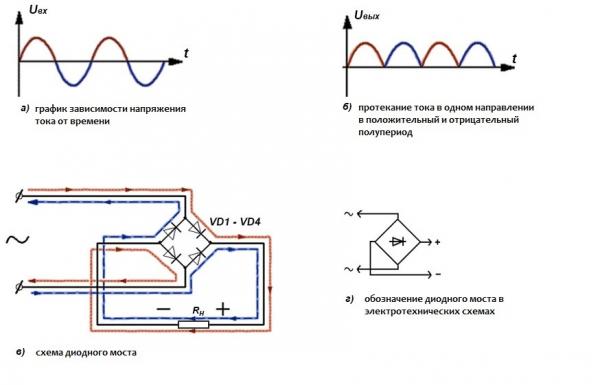 Fig. 2
Fig. 2 The diode bridge is a full-wave rectification circuit containing 4 diodes instead of one (Figure 2c). In each half-cycle, two of them are open and pass electricity in the forward direction, while the other two are closed and no current flows through them. During the positive half-cycle, the positive voltage is applied to the anode VD1, and the negative voltage to the cathode VD3. As a result, both of these diodes are open, and VD2 and VD4 are closed.
During the negative half-cycle, the positive voltage is applied to the anode VD2, and the negative voltage is applied to the cathode VD4. These two diode open, and open during the previous half-period are closed. The current flows through the load resistance in the same direction. In comparison with a half-wave rectifier, the number of pulsations doubles. The result is a higher degree of smoothing at the same capacitance of the filter capacitor, an increase in the efficiency of the transformer used in the rectifier.
The diode bridge can be not only assembled from individual elements, but also made as a monolithic construction (diode assembly). It is easier to mount, and diodes are usually matched to the parameters. It is also important that they work in the same thermal regimes. The drawback of the diode bridge is the need to replace the entire assembly in the event of failure of even one diode.
Even closer to the constant will be a pulsating rectified current, which allows you to get a three-phase diode bridge. Its input is connected to the source of a three-phase alternating current (generator or transformer), and the output voltage is almost the same as the constant, and it is even easier to smooth out than after the full-wave rectification.
Rectifier based on a diode bridge
The circuit of a full-wave rectifier based on a diode bridge, suitable for self-assembly, is shown in Fig. 3a. The voltage removed from the secondary winding of the transformer T is subjected to rectification. To do this, connect the diode bridge to the transformer.
The pulsating rectified voltage is smoothed by an electrolytic capacitor C having a sufficiently large capacitance, usually of the order of several thousand μF. Resistor R plays the role of rectifier load at idle. In this mode, the capacitor C is charged up to an amplitude value, which is 1.4 times the root of the current value of the voltage taken from the secondary winding of the transformer.
As the load increases, the output voltage decreases. To get rid of this drawback, you can connect a simple transistor stabilizer to the output of the rectifier. In principle, the image of a diode bridge is often simplified. In Fig. 3b shows how the corresponding fragment in Fig. 3a.
It should be noted that although the direct resistance of the diodes is small, nevertheless, it is different from zero. For this reason, they are heated in accordance with the Joule-Lenz law the stronger the larger the current flowing through the circuit. To prevent overheating, powerful diodes are often installed on heat sinks (radiators).
The diode bridge is practically a mandatory element of any electronic device that is powered from the network, whether it is a computer or a rectifier for charging a mobile phone.
Similar entries:
